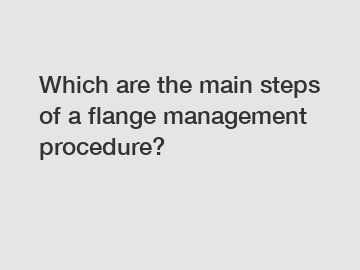Which are the main steps of a flange management procedure?
Flange management is a crucial aspect of industrial operations that involves the installation, maintenance, and inspection of flange connections. Flanges are vital components in pipelines and equipment, providing a secure and leak-free joint between pipes, valves, and other equipment. To ensure the safe and efficient functioning of flanged connections, it is essential to follow a well-defined flange management procedure. In this article, we will explore the main steps of this procedure and highlight their significance in securing optimal performance.
Step 1: Preparing for Flange Management.
Before commencing any flange-related activities, proper planning and preparation are paramount. This initial phase involves gathering relevant documentation, verifying specifications, and determining the flange ratings, sizes, and materials. It is crucial to have accurate and up-to-date drawings, standards, and procedures readily available. By ensuring such preparation, potential risks and complications can be effectively mitigated, thereby saving time and resources.

Step 2: Inspecting and Cleaning Flange Components.
Once preparatory work is complete, a comprehensive inspection of flange components should be carried out. Examine the condition of gaskets, flange faces, bolts, and nuts for any signs of damage, corrosion, or wear. Ensure that the flange surfaces are clean, free from debris, and without any remnants from previous installations or substances that could hinder effective sealing. Appropriate cleaning methods may vary depending on the flange materials, cleanliness requirements, and environmental factors.
Step 3: Selecting and Installing Gaskets.
Gaskets play a critical role in maintaining leak-free connections. Carefully select gaskets based on the specific application, considering factors such as temperature, pressure, and fluid compatibility. Ensure that gaskets conform to the appropriate material specifications and standards. Following selection, align the gasket precisely with the flange faces, ensuring it is centered and free from any distortions or overlaps. Careful handling and proper installation help to maintain the integrity of the seal.
Step 4: Tightening Bolts and Achieving Proper Bolt Load.
Achieving accurate and uniform bolt load across flange connections is vital for establishing a leak-proof joint. Employing an appropriate torque or tensioning method is crucial during the tightening process. Referencing the manufacturer's specifications and industry standards, apply the recommended torque or tension to each bolt gradually and progressively across the pattern. A controlled sequence ensures that the flange faces come into an optimal uniform contact, preventing excessive loads or misalignment.
Step 5: Inspecting and Verifying Bolt Tightening.
After the initial tightening, it is important to verify the effectiveness of the bolt load. This can be done through visual inspection, and if needed, using specialized techniques such as ultrasonic measurement or tension calibration. By conducting bolt load verification, any potential discrepancies or variations can be identified and promptly addressed, guaranteeing that the flange connections meet the required standards and specifications.
Step 6: Locking and Marking Bolts.
To ensure the integrity of the bolted joint, it is essential to secure the bolts effectively. Locking mechanisms such as double-nut, lock washers, or specialized locking devices should be implemented as per the project requirements. Subsequently, clearly mark the position of each bolt, noting the locking mechanism used and indicating the completion of the bolt tightening process. This step helps to prevent accidental loosening and simplifies inspection and maintenance activities in the future.
Step 7: Conducting Post-Installation Checks and Inspections.
The final step in the flange management procedure involves comprehensive post-installation checks and inspections. Examine all flanges and connections to ensure visual integrity and proper alignment. It is crucial to also inspect bolted connections periodically, following best practices and adhering to maintenance schedules. By proactively identifying and addressing any issues, such as leaks, corrosion, or misalignments, the overall efficiency and safety of the system can be maintained.
Conclusion:
Flange management is a critical process that requires meticulous attention to detail to ensure the reliable functioning of flange connections. The main steps of the flange management procedure involve preparation, inspection, gasket selection, bolt tightening, verification, locking, and post-installation checks. By adhering to these steps and considering industry standards, the risk of leaks, downtime, and accidents associated with flange connections can be significantly reduced. Strong flange management practices provide a solid foundation for the safe and efficient operation of industrial systems.
Are you interested in learning more about Flange Management Process, Flange Management Process, Flange Management Services? Contact us today to secure an expert consultation!
120
0
0


Comments
All Comments (0)